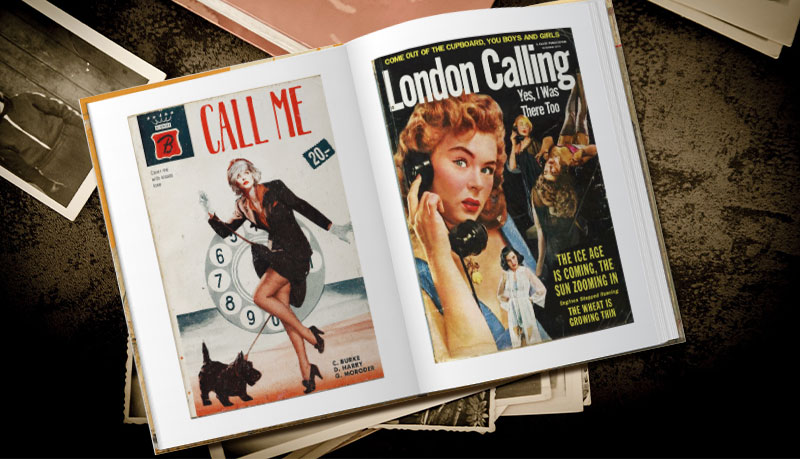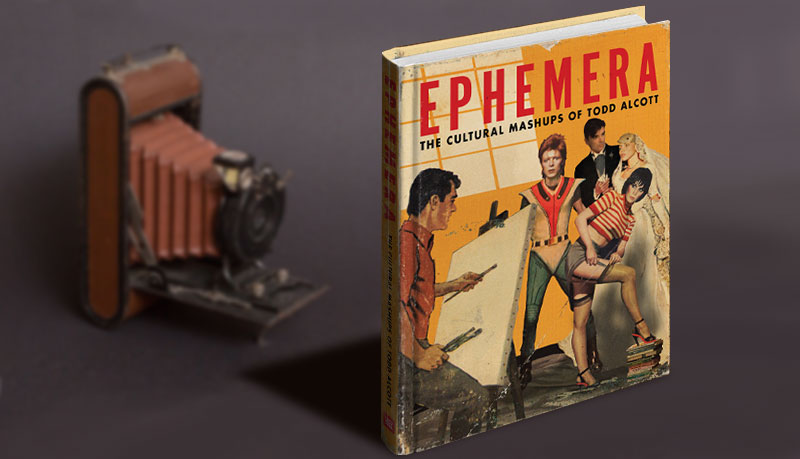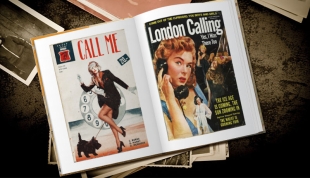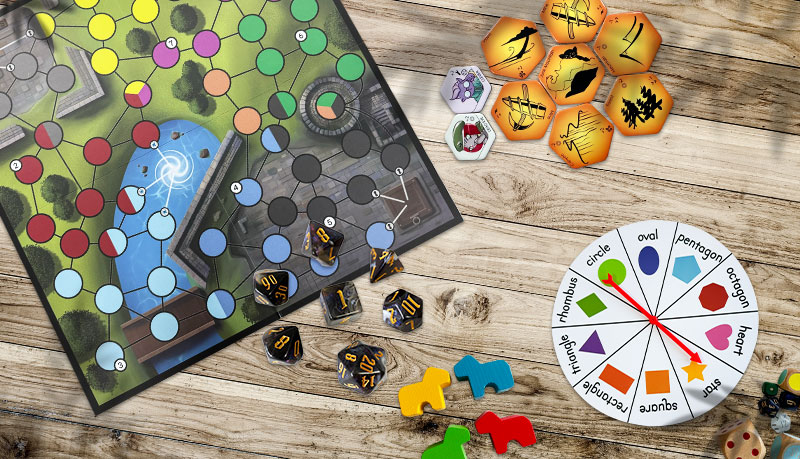Step-by-step instructions for writing and publishing nostalgia

Memories — and money — are made of this
Do you remember the good old days? Back in your youth, when the summers were longer, we had the best music and fashions, and life was so much sweeter, despite the world's problems? Can you conjure up those glory days gone by, and set them down in emotion-provoking, elegant, or humorous prose?
If you can write in a way that give the people “roses in December,” you stand a good chance of selling your self-published nostalgia book to eager readers keen to indulge memories of the past, insights into the present, and hopes for the future. Nostalgia never goes out of style. As every new generation grows up and transitions into middle age, it looks back fondly on its youth.
Whether you were young in the 50s and 60s, the 70s, the 80s, or the 90s, you'll find magazines, websites, blogs, TV and radio channels, social media groups, clubs, associations and societies — many of which have newsletters to which you can sign up to get more insight into this lucrative market — dedicated to nostalgia for the lifestyle, music, fashion, language, personalities, and atmosphere of those times. All of these are worth checking out and reading if you mean to write and self-publish a nostalgia book. They'll give you a good idea of the kind of writing that the market supports and the topics and style that readers love—and for which they are prepared to pay. Aside from hunting down and reading at least a dozen or so nostalgia books in your public library, on your e-reader, or from your local indie bookstore, you can also get lots of useful insights from popular nostalgia magazines. You could start with Reminisce, or The Good Old Days in the USA, and Best of British, The People's Friend, The Oldie, or This England in the UK.
There are many more, several specializing in nostalgia, and others more general in scope. You may even find an inspiring article in one of them—or several inspiring articles in several of them!—that spark ideas and memories of your own that would make the perfect departure point for a successful series of self-published nostalgia books. The first step to creating saleable material is always to research the market thoroughly. So, hit the library, fill your Kindle, browse the bookstores, and raid the newsstands. There's no reason research shouldn't be fun!
Nostalgia is not only for the older crowd
Modern life zips along at a speed that would have left our parents dizzy, not to mention our ancestors of 100 years ago or more. Every generation reaches a point where the political uncertainties, cultural changes, and social and economic upheavals of the day arouse a sense of anxiety. Often that feeling is coupled to a desire to go back to a period in which we felt more secure.
The irony is that people felt this same nostalgia for the past as keenly in times gone by as they do now. As far back as the 14th century, Geoffroi de la Tour Landry, a knight of France, penned the lines:
“Things aren't what they used to be
How I long for the old times again!”
And in the early Victorian period in Britain — a time of rapid technological and social change similar to our own — writers and artists such as Dickens, Hardy, Browning, Tennyson, and the Pre-Raphaelite Brotherhood, satisfied the yearning for a bygone age of certainty and deep human values in their romantic novels, poetry and painting.
Nostalgia stories have a strong appeal for older people as they look back at their lost youth through their proverbial “rose-tinted spectacles.” But nostalgia books are not only for the older generation. A thirty-something can just as well enjoy reminiscing about her teen years, and teens may read with interest about what life was like for their parents and grandparents.
A powerful way to give any self-published nostalgia book appeal which spans the generations is to use the “compare and contrast” technique. So, if you want to write about your first date, you might refer to the way we used to date back then — whenever that may have been — and now. Perhaps you had to wait to ask a girl out to a dance, chaperoned under the watchful eyes of family or teachers, whereas now, young people swipe their smartphone screens in search of a potential partner and maybe “meet” for the first time via WhatsApp, Face Time, Skype, or Zoom, for example. You might lament those changes, or take the opposite view that young people are freed from the oppressive restrictions of your youth. That's just one example, but whatever you write about, it's worth thinking about the “then-and-now” approach.
Nostalgia books must have broad appeal
But there's much more to the nostalgia story than mere sentimental longing. Sentimental fantasies are, in fact, a hard sell. Readers want a combination of a genuine feeling for past times and thorough research and historical accuracy. The simple truth is that no-one is likely to be interested in — and still less pay for — the personal reverie of an unknown Joe whose recollections may not be much different from anyone else's.
Nostalgia books, then, must have broad appeal. So, even memories of your personal experience must be treated so that they connect with universal needs — health, love, security, belonging, accomplishment, and recognition, for example — and trigger emotion-filled memories in the reader. The response you should inspire is, “Ah yes, that reminds me of when…” A good nostalgia book never really focuses on the author, but always on the emotional experience and memories that the author seeks to evoke in the reader.
When planning a nostalgia book, think first about the universal theme which you will express through the lens of your personal experience and memories. Ask yourself, “Will the story I tell be recognized by the reader, triggering fond memories from their own past?” You can begin with any of the “universal themes” mentioned earlier, then zoom in on a life-stage experience that most people go through. Here are just a few examples:
- Schooldays
- Falling in love for the first time
- Getting married
- Your first job
- A significant historical event
- Memories of your grandparents
- The birth of a child
- Sporting events
You'll be able to think of many more. But the ideas above should get you thinking along the right lines. Any idea could be good material for a self-published nostalgia book so long as it's one that the reader can connect with and that will inspire their own nostalgic memories to spring vividly to life.
Research, accuracy, and fact-checking
While you don't need to base a nostalgia book on historical research, you mustn't assume that you can trust your memory. Any factual claims you make must be checked for accuracy. Partly, this is a simple duty of care so that you don't inadvertently mislead or misinform a reader. But it's also important because there's a good chance that a reader will know if you make a mistake.
Research may also be necessary to fill in the background with important information that doesn't come readily to mind — a particular brand of product, the name of the President back then, which song was at the top of the hit parade, or which team won the World Series, for example. It's unlikely, however good your memory, that you'll have enough information to furnish the reader with an accurate and evocative picture of the period without doing at least some research. You can look in books, search the web, and talk to contemporaries to make sure you get your facts straight. Research will also help you find emotion-provoking details that will make your words spring off the page and come to life in the reader's imagination.
How to write nostalgia without ego
One of the main reasons that readers give up on nostalgia books they've started reading is that the author's writing is too egotistical. That doesn't mean the author is boastful or arrogant, but that they write exclusively about themselves, their experiences, their thoughts, and their feelings without “opening the door” to the reader. You can quickly see from reading over the first few pages when a nostalgia book is likely to exclude the reader because it will overuse the first-person pronouns “I,” “me,” and “mine.”
To write nostalgia in the confidential, warm style most nostalgia readers love, try to use the personal pronouns “you” and “yours,” or “we,” “our,” and “us” instead. Imagine you're describing a memory that you share intimately with your reader, rather than a purely personal experience. Your style should be that of someone reminiscing together with a close friend or family member. Here's an example of how to avoid egotistical writing and use the kind of language which invites the reader in:
Egotistical: “I used to love the rush from the school gates to the corner store, my few coins jangling in my pocket, eager to exchange them for a quarter ounce of my favorite candies.”
Inclusive: “Do you remember the rush from the school gates to the corner store, a few coins jangling in your pocket, eager to exchange them for a quarter ounce of your favorite candies?”
Inclusive: “Most of us remember the rush from the school gates to the corner store, a few coins jangling in our pockets, eager to exchange them for a quarter ounce of our favorite candies.”
You can tell the same story in almost the same words, but in the inclusive examples, you invite your reader to share in the memories you evoke. This is vital to understand. Readers aren't interested in your memories. They're interested in the way that your memories can evoke theirs. Choosing a story that taps into a universal theme or common experience must be coupled with using the right kind of language to make your writing style and story do their job.
Use all six senses in your writing
To evoke the most suggestive memories and give your nostalgia writing impact, make sure you use all six senses. No, that's not a mistake. These are the senses you should include in your story:
- Sight — colors, styles, architecture, clothes, hairstyles, street signs, anything visual that was typical of the times
- Hearing — the music, accents, language of the period and any other sounds that maybe have been lost in the modern environment
- Smell — odors, perfumes, and aromas are especially evocative of time and place and likely to conjure up memories in your readers' imaginations
- Taste — taste is closely connected to the sense of smell. Include flavors — a brand of soda pop, home cooking, or your first kiss, for example — to draw your readers into a vivid sensual world of memories.
- Touch — sensations are powerful and should be woven into your writing. Think of the feel of the leather upholstery in your first automobile, the scratchy shirt your grandma insisted you wear, or the smooth weight of a vinyl record, for example.
But wait a minute, that's only five. What's the sixth sense? The sixth sense is your sense of humor. Not all nostalgia books include humor, and you don't need to try for laugh-out-loud jokes—although you could be on to a winner if you have a talent for making other people laugh—but much nostalgia writing quietly acknowledges the fact that it's presenting a selective view of the past, and if you can soften the “harder edges” with a touch of humor and a wry smile, your self-published nostalgia book will have added depth, richness, and resonance.
One story well told
When you set off down memory lane, it's easy to end up meandering through the past, following every diversion that piques your interest. But to write a good nostalgia book that readers are likely to buy, you also need to make sure that you keep the focus of your story tight. This is not a memoir or autobiography. Although the nostalgia book has much in common with both, it's more focused and has a different purpose in mind. So, choose one theme, tell one story, and tell it well.
The best way to do that is to plan your book's structure before you begin. Don't worry if you have several ideas or even a range of potential takes on a single idea. That's great! Most successful self-publishing—and in any modern publishing come to that—relies on building a readership over time by publishing a series of related books. You may hit the jackpot with your first book, but that would be unusual. Most self-publishers start to see real success once they have three published books under their belt. That's also why in mainstream genre publishing the “trilogy” and the “three book deal” is so popular. But, no matter how many books you write, you should take note of the most popular structural elements of an effective nostalgia book, as well as the fundamentals to increase your chances of self-publishing success.
- Most nostalgia books open with what's known in the industry as a “lead” – typically one to five opening chapters which set the scene with carefully selected, sensual, emotion-provoking details, while establishing the tone and voice of the author, and introducing the theme or core idea. To help keep focus, a good technique is to start by asking a question, which will then be explored, and finally, answered.
- Next, having set up the past, most nostalgia books return to the present to compare times gone by — usually favorably — with the current state of things. Making this connection between the past and present is important to give your self-published nostalgia book broad appeal while keeping the focus tightly on the central theme. If you opened with a question—whether stated directly or only implied—this is the main body of the book in which you explore the ideas, feelings, images, and arguments which will reveal an answer through going back into the past once again.
- Finally, most successful nostalgia books come “full circle,” returning to the scene first described in the lead, but now adding in the insight and perspective gained during the middle section. If you raised a question at the outset, this is where you answer it.
But never forget that nostalgia readers—unlike some memoir or autobiography readers, for example—don't want “challenging” material in a nostalgia book. People read nostalgic books to escape the trials and sorrows of life. Keep your themes light, and your writing style cozy and entertaining. Leave your reader with a warm glow, gazing contentedly into the middle distance, with a wistful smile on their face.
Seasonal sentiments and forward planning
You can also write, self-publish, and sell nostalgia books based on seasonal celebrations like Christmas, Easter, summer vacations, and Halloween. The key to success with a seasonal story is to make sure it's written, edited, proofed, printed, and published and prepared for distribution for the first time well in advance of the season to which it refers. Subsequently, you'll see ‘spikes” in sales each time that season comes around. Another good reason to print and publish a series of nostalgia books; in this case, so there's always one selling well at any given point in the year. Most mainstream publishers—and successful self-publishers—plan their seasonal releases at least six months ahead, so if you have an idea for a Christmas nostalgia book, for example, you should have it all ready to go in May to give you time to market it and build up buzz around its eventual release.
Anniversaries of significant political, social, sporting, and cultural events are also good “hooks” for nostalgia books. It's worth keeping a calendar of these dates and searching the various almanacs available in print and online. Again, getting your story written and ready to submit in advance will boost your chances of getting it noticed by potential readers on time for the launch.
Seven steps to success writing and self-publishing nostalgia books
So, to write and sell nostalgia books successfully, you need to carry out the following seven steps. They won't necessarily guarantee you a bunch of sales right off the bat. To succeed at self-publishing anything, you need to be in for the long game But, if your writing is good and you have a feel for the market, they will give you the best chance of seeing your work in print and extra dollars in your bank.
- Research the markets in detail, reading widely and critically and making plenty of notes. Focus on the books, articles, and stories you most enjoyed, and think you could write in a similar style.
- Select a “universal theme” and link it to a situation, event, or life stage that your readers can relate to and will have experienced.
- Check all your facts for accuracy and “fill in the gaps” in your memory with careful research.
- Write a well-structured story full of vivid, emotion-provoking details, using the five senses, and the magic “sixth sense”; your sense of humor.
- Make sure to compare and contrast “then” and “now” to illustrate your key point and make the book accessible to younger readers.
- Remember to write using the second person (you/yours) or the first person plural pronouns (we/ours/us) to make sure your ego is out of the way and your reader can identify with the story you tell.
- If you choose a seasonal angle, remember to plan your marketing and launch schedule at least six months ahead of your chosen date.
These are the fundamentals to understand and put into practice to write a successful self-published nostalgia book suited to this perennially popular genre. And remember to enjoy it. If you're in love with your material, brimming with enthusiasm, it will shine through in your storytelling and your writing and transmit the same feel-good atmosphere to your readers. That's what they're looking for in your book.
What format is best for a nostalgia book?
Most nostalgia books are published in hardcovers and the text accompanied with plenty of evocative photographs, images, and illustrations in full color. While nostalgia books should have a clear focus and an engaging narrative flow, as we discussed earlier, readers also love “dipping into” them, to look at pictures or re-read a favorite section. So, there are several good reasons to print a hardcover edition of your self-published nostalgia book:
- Nostalgia books may be formatted similarly to novels, but they are often created also as coffee-table style books or large format art and photography books. For these editions, hardcovers are essential.
- Because nostalgia books are usually read, re-read, and re-visited many times over the course of several years, they need to be more robust and durable than a paperback. Hardcovers protect the content and provide a more robust casing that can last for generations.
- As most nostalgia books are heavily illustrated with photography and color prints, you'll need thicker, coated paper to give you the best quality reproduction. This necessarily results in a slightly bulkier book, so the binding needs to be strong enough to carry the additional depth of pages, which hardcovers do effortlessly.
- Promotional activities for nostalgia books often involve giving talks, making visits to clubs, schools, societies, bookstores and libraries, not to mention book fairs and conventions. A beautiful, full-color hardcover edition looks better on a stand and offers the added “real estate” of endpapers to facilitate book signings.
To learn more about what's involved in printing a hardcover book—including paper and covering options, costs, and special features—check out our dedicated page, Hardcover Book Printing.

And that's it. The first step is to research the market, which reading a lot of books and articles in the nostalgia genre and finding out where readers and fans gather and chat on- and off-line. It means looking at each publication with a writer's eye and making a careful, step-by-step analysis of the stories, style, length, illustrations and other elements so you know exactly what readers are looking for before you begin to put your ideas together and write your own self-published nostalgia book.
Don't be discouraged if your first book doesn't shoot to the top of the bestseller lists overnight. Self-publishing is a long game and you'll need to do your fair share of marketing and promotion to get your book reviewed and stocked and into the hands of eager readers. Most self-publishers start to see significant success only after they've published their third book. So if your first one doesn't “fly off the shelves” it's most likely not your writing that's at fault. It could simply be that you need more time, and another book, to continue to build your reputation. Keep at it and keep improving your craft, and if you have the right mindset, you have as much chance as the next writer to break into and make a success in the nostalgia market.
Let's talk! We're here to help.
Researching the market, getting an idea for your story, writing the text, editing it, proofreading, gathering photographs and commissioning or sourcing illustrations, designing the layout and printing your finished nostalgia book for self-publishing, distribution and sale, is often as challenging as it can be rewarding. At QinPrinting, we take immense pride in our unbeatable, personalized customer service and helpfulness as much as our collective knowledge of each aspect of the latest, state-of-the-art printing processes and technology. Get in touch today to discuss your individual needs or to request a no-obligation quote.
Shoot us an email to [email protected] or call us at +1 951 866 3971 and we'll be delighted to discuss your needs.









